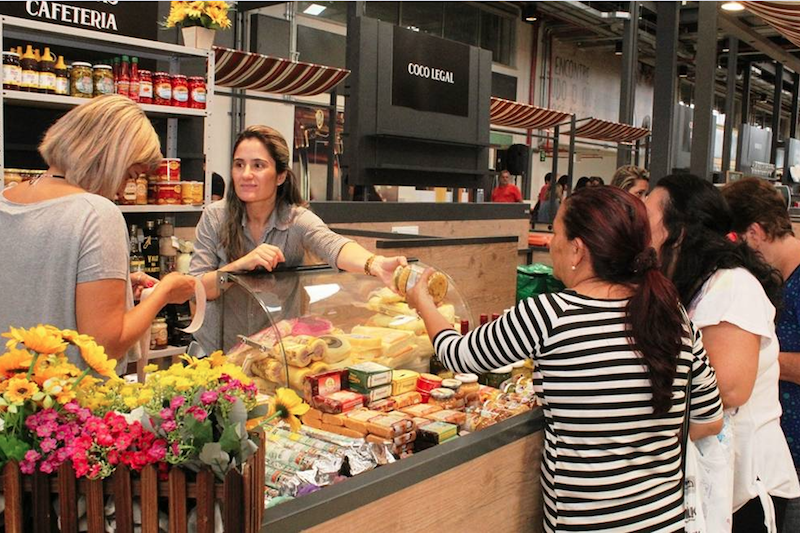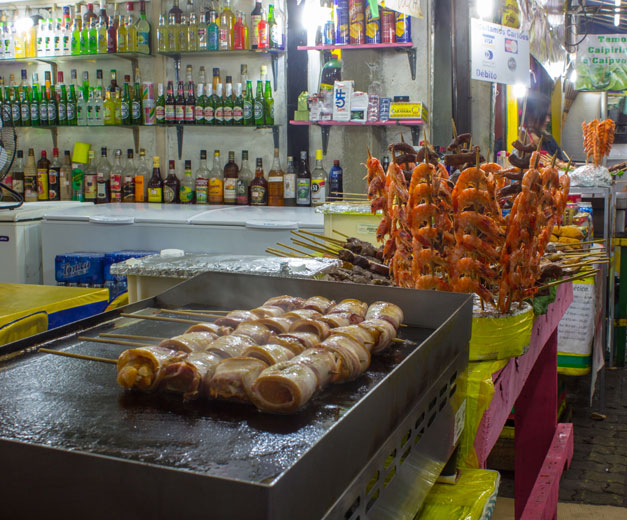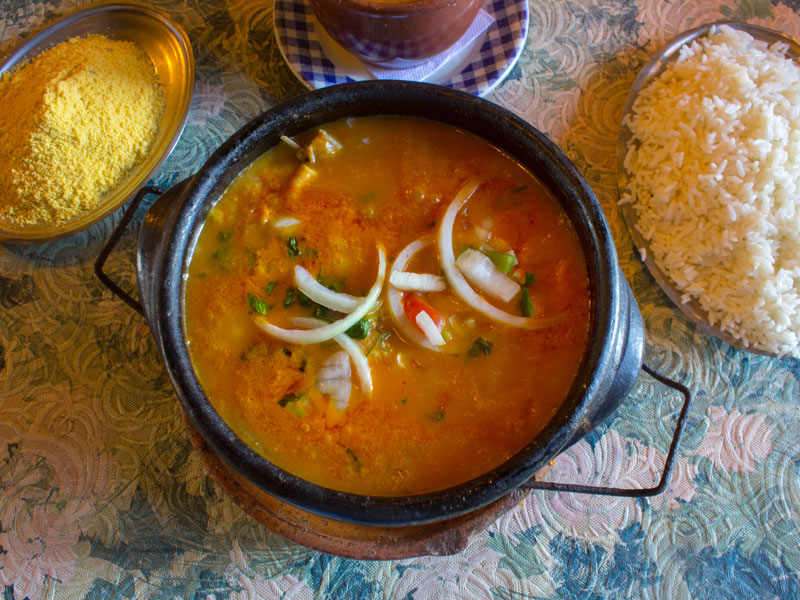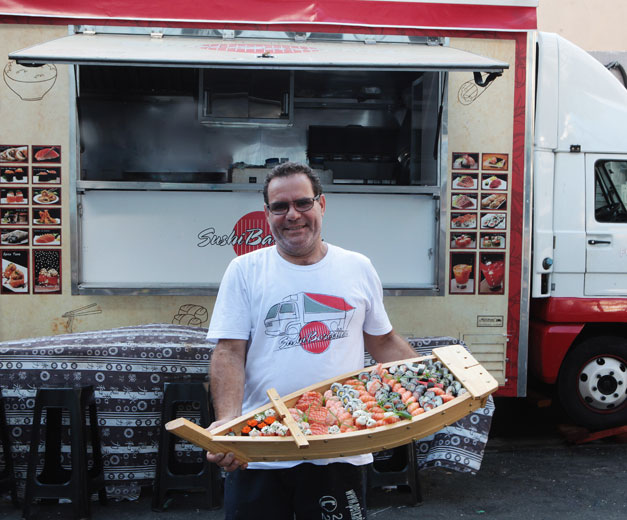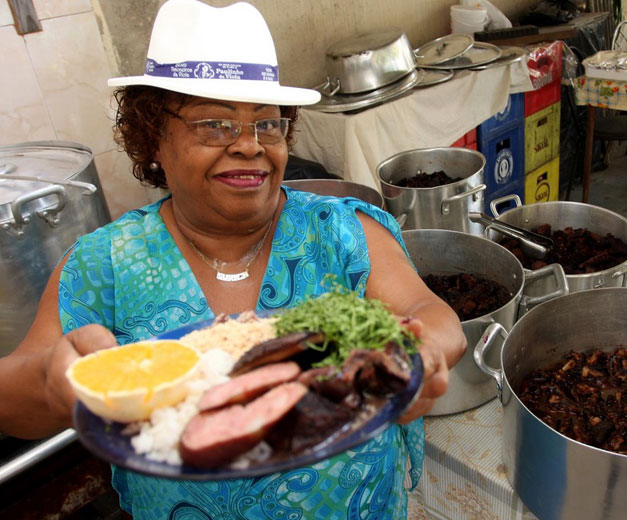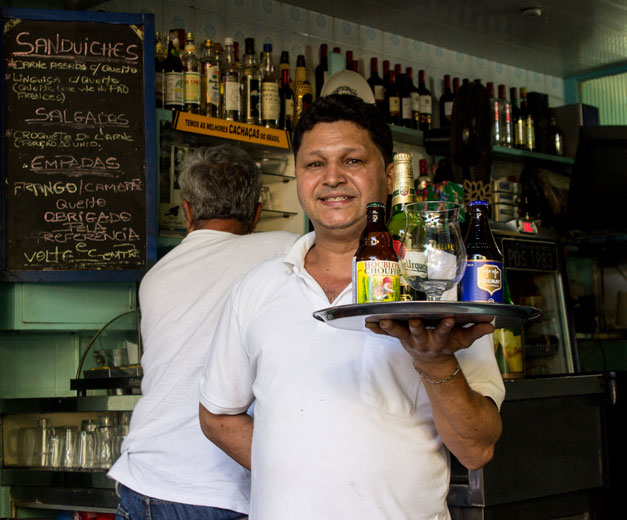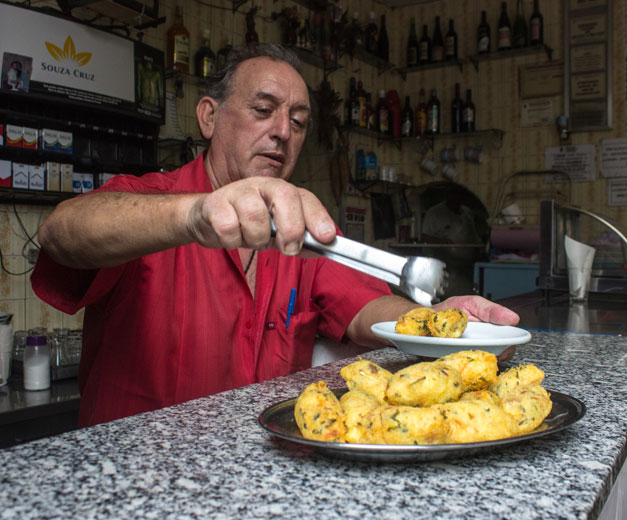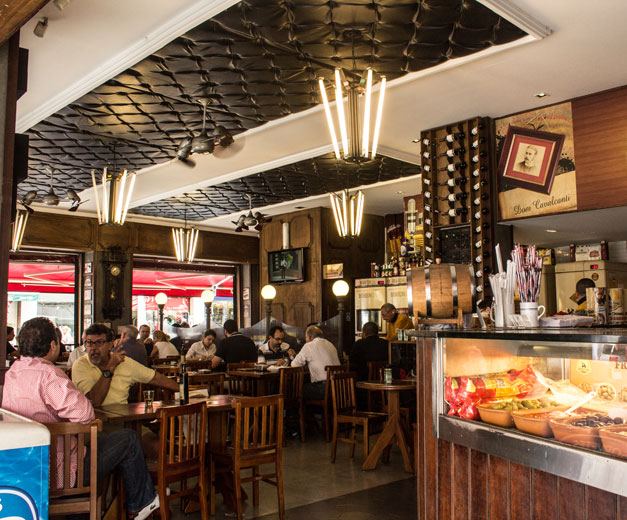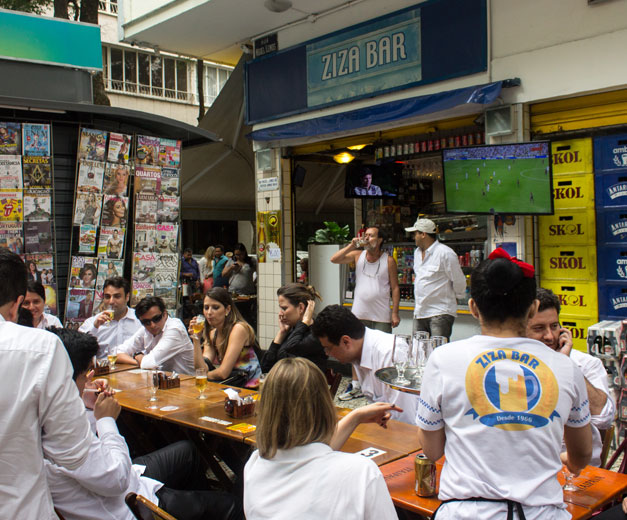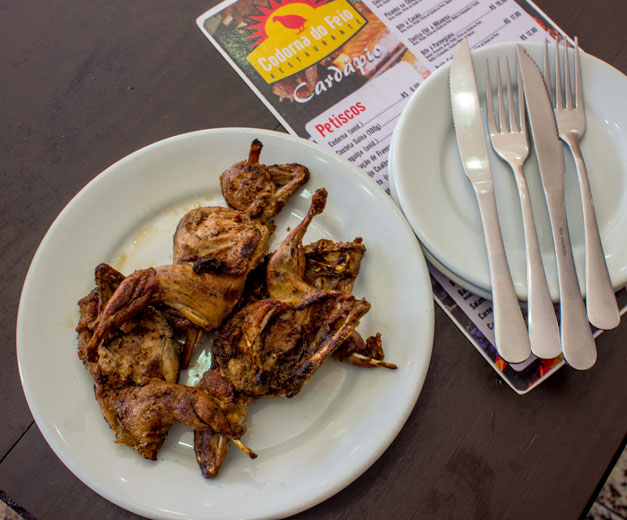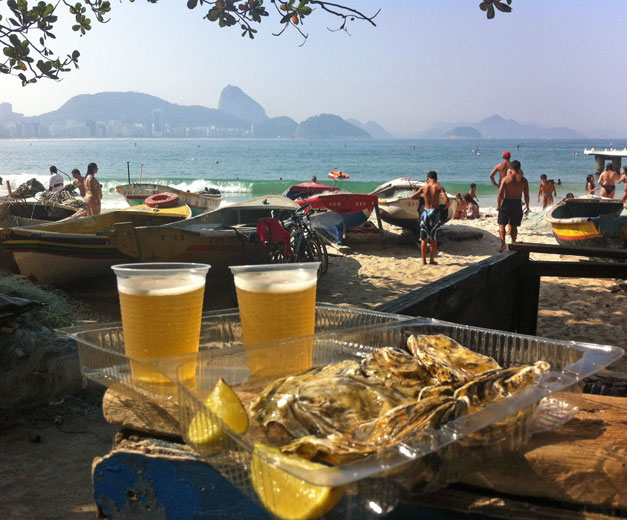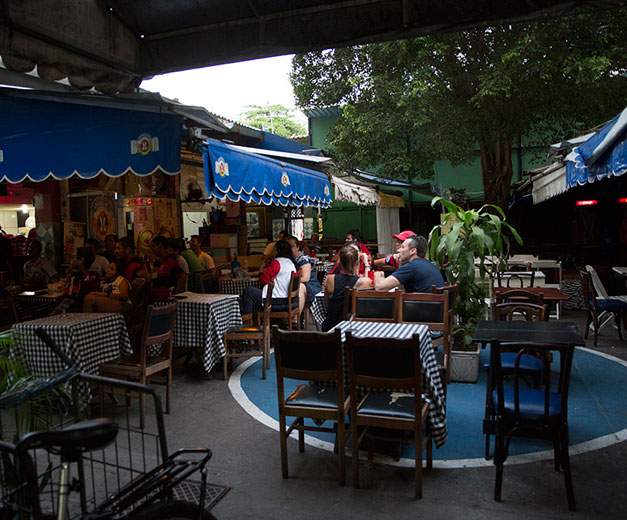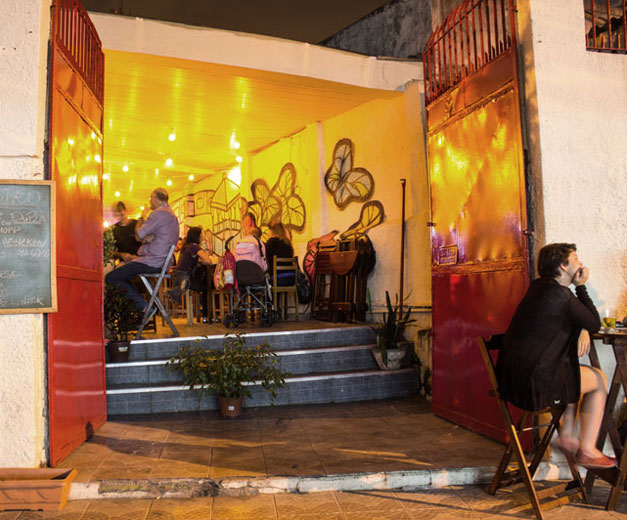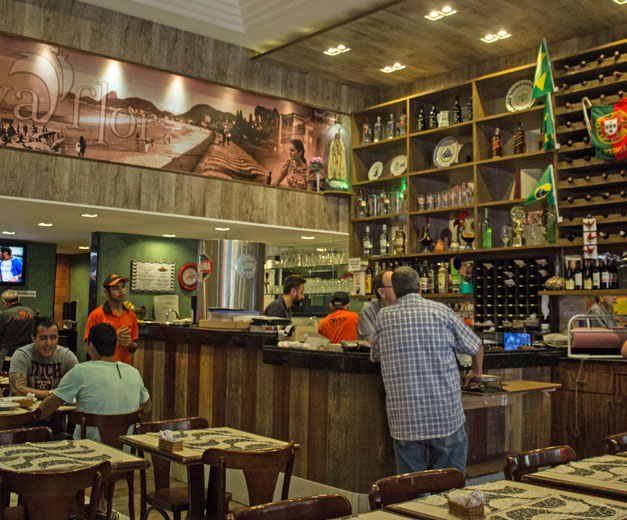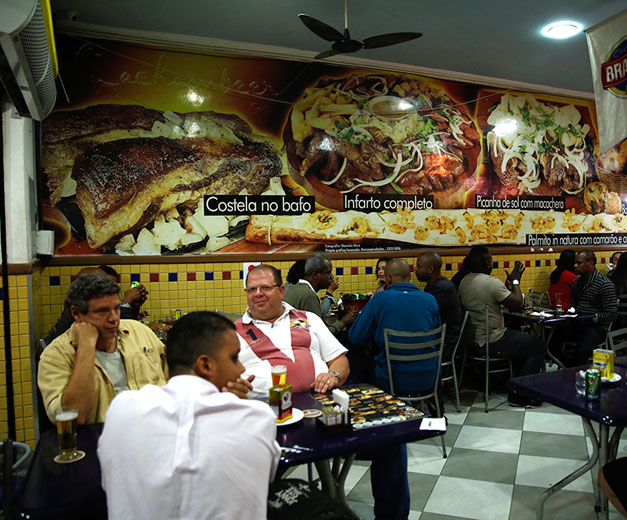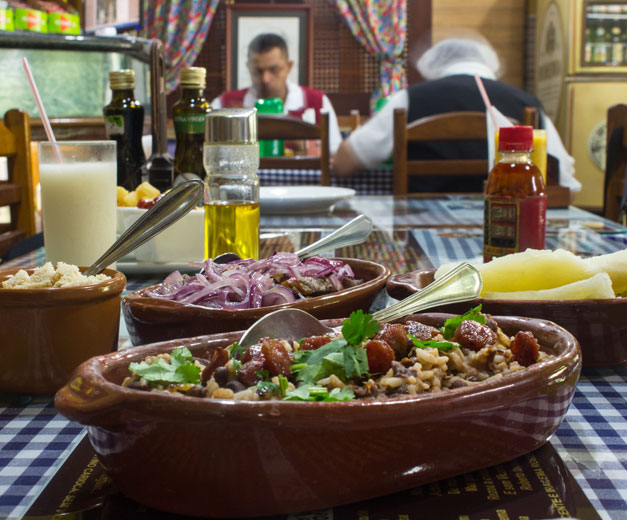We can't find the internet
Attempting to reconnect
Something went wrong!
Hang in there while we get back on track
Search results for "Juarez Becoza"
Rio
Galeto Sat's: Spring Chickens and Sugarcane Spirits
Although there are plenty of bars on Copacabana’s famous Avenida Atlântica – or even at the beach, at the so called quiosques – very few are worth a visit. Many are just tourist traps. Others are much too expensive. No, the really good bars in Copacabana are inland, along Barata Ribeiro street. That road, along with some of the side streets that let onto it, reveals the true face of Copacabana's popular gastronomy. One of the first bars you encounter on Barata Ribeiro is Galeto Sat's. Open seven days a week, always until 5 a.m., the bar is a bohemian temple – but it’s far from being only that. For many cariocas, Sat's serves the best galeto in town. A galeto is a very young chicken (no more than three months old) cooked over a big coal-fired grill.
Read moreRio
Pavão Azul: Play It Again, João
There’s one thing about the very popular Copacabana bar Pavão Azul that remains a mystery, even after 60-odd years of business: its name. Pavão azul means “blue peacock” in Portuguese, but even the owners don’t know where this curious name come from. Some customers who have been frequenting the bar since it opened in the 1950s say that it was named after the bar in the movie “Casablanca” – except that that place was actually called the Blue Parrot. What’s not a mystery is the bar’s popularity. Once just a regular old botequim – a small bar serving simple food – Pavão Azul was discovered by food critics thanks to its patanisca.
Read moreRio
Titú: Octopus’s Garden
When we first entered Titú, a new spot in the trendy Botafogo neighborhood, our mind immediately went to SpongeBob SquarePants, oddly enough, or more specifically, the Krusty Krab, the diner where SpongeBob works as a fry cook. Like the Krusty Krab, this recently opened bar specializes in seafood burgers – when we popped our head into kitchen, we saw a mountain of patties awaiting the grill. The only difference between Krusty and Titú – besides the fact that latter is real and the former is merely a fantasy under the sea – is that at Titú the burgers are not made of crab, but of octopus. Delicious and tender baby octopuses, captured in the waters off the coast of Rio de Janeiro.
Read moreRio
Mercado de Produtores Uptown: Shelter from the Storm
Twenty years ago, Rio de Janeiro was teeming with food markets: big indoor venues full of stalls where people could go to buy groceries, fresh meat and produce, but also stay for a while to have a drink or two, maybe some appetizers, or even sit down for a meal. As time went by cariocas spent less time in these markets, instead shopping in grocery stores and eating at restaurants; the markets continued to limp forward only because of some strong-willed and stubborn merchants who refused to shut down their businesses.
Read moreRio
Art Chopp: Smoked Success
Five years ago, Diogo Gomes, the owner of Art Chopp, a bar in the Jacarepaguá neighborhood, was seated at one of the bar’s 36 tables. There were no customers: only him, the cook and two waiters. The heavy rain falling outside began to drip from the ceiling and soak the floors. Even wetter, though, was Diogo’s face – he was crying, he later explained to us, because he was sure that he would have to shutter the empty bar and give up on his lifelong dream. In addition to the lack of customers, he was facing a mountain of debts; Diogo was one step away from bankruptcy.
Read moreRio
Pop up Peru: Home Cooking
Over the last couple of years, Rio de Janeiro’s food scene has experienced a Peruvian invasion. Encouraged by the buzz of the 2016 Olympic Games, more than 10 restaurants and bars focused on Peruvian cuisine opened up shop in Rio. But many of those spots are fine dining establishments, plating up the kind of sophisticated cuisine found in Lima – the capital of Peru is a culinary powerhouse and one of the best places to eat in the world. But there are exceptions. We stumbled on one in an old house in the Botafogo neighborhood. At this restaurant, called Pop up Peru, there are no fancy decorations, nor any kind of complex contemporary recipes. Even Lima’s influences are conspicuously absent.
Read moreRio
Põe na Quentinha: The Edible Samba Parade
When it first began five years ago, Põe na Quentinha was an informal get-together for people who were equally passionate about food, beer and samba; they spent the day eating, drinking and dancing in preparation for Carnival. Fast-forward to 2017, when what had now developed into a proper street parade drew in over 5,000 people over three different days during the Carnival Season. This year, the food-focused event, the only one of its kind in Rio, is even larger, hosting a full month-long schedule of parades that started in mid-January.
Read moreRio
Beans & Beats: Pre-Gaming Carnival 2018
There’s one thing about Rio’s gastronomy that just about everyone can agree on: feijoada, the glorious black bean and pork stew served with cabbage, toasted manioc flour, rice and oranges, can (and should be) eaten all year long. But during the Carnival season (a non-specified period that begins in early January and extends until one week after the Carnival holidays), the Brazilian national dish becomes the official meal of all parties and events. From Friday to Sunday, feijoada is everywhere – at samba schools, bars, restaurants, fancy hotels, and even on the streets – and almost always accompanied by samba. This year is no different. The feijoada season has already begun, and the agenda is packed until Carnival, which in 2018 runs from February 10-14.
Read moreRio
Mania de Boteco: A Bar in the Sky
It’s not easy to get to Mania de Boteco. You have to go up, up, up, first by car (or, for something more thrilling, on the back of a motorcycle taxi) and then by foot, cutting across alleys and climbing narrow stairwells. But this spot is worth all the effort. Tiny and humble, Mania de Boteco has an almost improvised feel to it, teetering at the top of Vidigal, one of Rio’s most scenic favelas. The first thing noticed here is the astonishing view of the ocean and Leblon and Ipanema beaches down below. But Mania de Boteco is more than just a scenic spot: it also happens to be a top-notch botequim serving wonderful food and amazingly good drinks.
Read moreRio
Best Bites 2017: Rio de Janeiro
Brazil’s economic crisis has hit Rio hard this past year, and the culinary scene was by no means immune from the downturn. Some famous restaurants and bars closed their doors for good. But the city hasn’t given up. In fact, if some doors have closed, a lot more have opened. Because now creativity is being used as a weapon against the crisis, and not only at newly opened spots. Established bars and restaurants have been reinvigorated with new ideas and processes. In this atmosphere, many exciting culinary novelties have made their way to the streets, ready for us to indulge in, all without having to spend too much money. So my best bites of 2017 reflect this abundance of good and cheap novel eats that have become so popular in these leaner times.
Read moreRio
Os Imortais: The Born-Again Botequim
There’s a new phenomenon in Rio’s botequim scene. Until some years ago, running one of these small bars was something done exclusively by immigrants from Portugal, Spain and Brazil’s northeast. But ever since botequims became extremely popular among the carioca middle class, new players have gotten into the business: the customers themselves. Since the beginning of the 21st century, it has become more and more common to hear about botequim customers who decided to buy the bars they used to frequent. Initially, it might be to help the former owners and to keep the bar from closing due to financial problems. But then they might notice that running a botequim in Rio can be enjoyable – and also good business, if the job is well done.
Read moreRio
Baródromo: Year-Round Carnival
Carnival in Rio is one of the world’s best parties, and for good reason. There are the extravagant costumes, the sweaty entertainers and revelers dancing to roaring samba music, and, most importantly, free flowing alcohol: Public inebriation, whether from drinking cheap beer or slurping spiked popsicles, is heavily encouraged. While nothing can top this pre-Lent bash, a newly reopened entertainment temple in Lapa offers a Carnival-like experience year-round. At Baródromo, you can soak in the Carnival ambience while downing delicious beers, eating well and listening to the best samba music out there.
Read moreRio
Lá na Rosi: Big Chef, Small Kiosk
The sun is already down when the food kiosks at the entrance to the Z10 fishing colony open their doors. It’s evening and we are on Ilha do Governador (Governor’s Island), the largest island in Guanabara Bay and far away from Rio’s tourist spots – the only reason most visitors come to this working-class suburb is to catch a flight at the Rio de Janeiro International Airport. These kiosks are almost all alike: boring food stalls serving bland seafood broths, bad pizzas and standard sandwiches. But six months ago, a new kiosk set up shop, one that was completely different from the others. It’s called Lá na Rosi and serves some of the most amazing street food in Rio.
Read moreRio
Contemporâneo Lapa: Bar Snacks from Afar
Lapa is the heart of bohemian Rio de Janeiro, a place that pulses with samba music and the clamor of bargoers. Local musicians, artists and intellectuals (and tourists, too) flock to this old neighborhood, which during the day is best known for its rich stock of colonial-era architecture and where at night more than 200 bars fight for customers. Almost all the bars offer the same thing: live samba music, cheap beer and bad food. But Contemporâneo Lapa is bucking this trend. The bar is situated on one of the most frenzied blocks in Lapa – it’s brimming with prostitutes and drug dealers (the neighborhood hasn’t completely shed its dubious reputation) as well as tourists and Cariocas chasing a wild night out.
Read moreRio
Bar do Seu Domingos: Suburban Meat Feast
When we talk about the “suburbs” in Brazil, some may imagine the affluent outer boroughs of London, New York or Singapore. But in Rio de Janeiro, they’re nothing like that. Far from its beautiful beaches, Christ the Redeemer and Sugarloaf Mountain, the city’s suburbs are the opposite of tony – they’re where Rio’s working-class people live. Yet the suburbs are where you can find the most authentic carioca soul. They are home to the biggest favelas, the most important samba schools, Afro-Brazilian religious temples, the majority of football fields and, of course, the best botequins, or local bars.
Read moreRio
Kalango: Northeast Vibes
The calango is a tiny lizard commonly found in the hottest, driest and poorest parts of Brazil’s Northeastern countryside, and in popular culture, the calango is also a symbol of hunger. Someone who eats calango is driven to do so because he has nothing else to eat. Thankfully, at Kalango there’s plenty to eat. Kalango (the “K” is for chef Kátia Barbosa, owner also of Aconchego Carioca) is a spartan botequim, or small gastropub, located near downtown that serves the specialties of Brazil’s Northeast states. This comida sertaneja, as it’s called, is very hard to find in Rio.
Read moreRio
Tasca Carvalho: Porto Meets Rio
Portuguese gastronomy is at the core of Rio's botequins, the small, often family-run gastrobars spread all over the city. Traditional botequins offer European food and some unique aspects of Brazilian culture – mix you’ll find only in Rio. That being said, it’s hard to say whether Tasca Carvalho, the brand new Portuguese gastrobar in Copacabana, is a typical botequim. Run by two young Portuguese friends newly arrived from Porto, Tasca Carvalho is not a mix, but 100 percent Portuguese. And that makes it unique in Rio's street food landscape. Perhaps the only indication of Brazilian influence you might find at Tasca Carvalho is in the ambience. The tables and benches, spread all over the sidewalk, follow the carioca rules of informality.
Read moreRio
Salve Simpatia: Across the Bay
Cariocas don’t give much love to Niterói, joking that the only reason to go to this city across Guanabara Bay is for its spectacular view of Rio de Janeiro. But while less busy and far less popular than Rio, Niterói is full of lovely beaches, great museums, excellent restaurants and hundreds of bars. Among the many reasons to visit is Salve Simpatia, a botequim – or small, family-run bar serving snacks to go with drinks – where traditional bar gastronomy mixes perfectly with delicious artisanal burgers, specialty beers and remarkably good music, especially samba. Salve Simpatia (which means something like “Hello, my brother” in Portuguese) opened in 2012 and was known only to locals in the Icaraí area for a while.
Read moreRio
Bacalhau do Rei: Long Live the King
A tourist visiting Rio is very likely to hear mention of Baixo Gávea, or B.G. It’s a very famous square, surrounded by bars and restaurants where young, rich and beautiful cariocas get together. The place is packed almost every night and especially inside the two bars that dominate the bohemian scene there, serving cold draft beer, pizzas and grilled meat. Baixo Gávea is undeniably cool and makes for a good time, but it can also be a bit disappointing if you don’t like crowded places or don’t have much money to throw around. But not to worry: There’s a way to enjoy Baixo Gávea without the unnecessary fuss and frippery – and to eat well while doing it (probably better, in fact, than you would in the more famous restaurants).
Read moreRio
Beans & Beats: Pre-Gaming Carnival 2017
In Rio, there’s a saying, “And once again, suddenly it’s Carnival.” It’s a joke, of course – as if Carnival didn’t occupy cariocas’ minds a significant part of the year. But the truth is that, in a way, this is precisely what’s going on right now in the “Wonderful City.” Official Carnival events begin in two weeks, but the samba shows, parties, feasts and merriment are everywhere. Suddenly, it’s already Carnival. And this early Carnival mood expresses itself better every year at the samba schools’ rehearsals for the official parades, which are scheduled to begin on February 24. From next Thursday until then, at least 15 parties will take place at the most important samba schools’ headquarters, as well as in the Sambadrome – Rio’s main parade zone – itself.
Read moreRio
Bar Roda Viva: Pig Out
Once upon a time, three brothers decided to immigrate. They left their hometown, an extremely poor city called Canindé, in the northeastern state of Ceará, went to Rio de Janeiro and started working in construction. They built a lot of brick walls, ceilings and roofs. Then, after two years of hard work, they decided to open a bar where they would sell roast chicken, northeastern food and grilled pork ribs. That bar, officially called Roda Viva, became known as Três Porquinhos (Three Little Pigs) when a customer connected the image of the three brothers working together with the classic children’s tale.
Read moreRio
Hocus Pocus DNA: Magic Brew
In Rio, only specialty beer bars usually have a touch of sophistication, and generally, the beer there is much more expensive (mainly because of the high tariff on imported hops), the regulars are more demanding and the food is made by a “chef.” This in contrast to the humble botequim, the traditional family-run bars that serve simple snacks. But Hocus Pocus DNA strikes a balance between the two: it’s a brand-new bar with a botequim soul that slings craft beers and thoughtfully conceived appetizers to go with them. It’s also the name of an acclaimed artisanal brewery – one of the best local breweries in town, in fact, operating in Rio since 2014 – whose products are sold only in specialty stores and bars.
Read moreRio
Best Bites 2016: Rio
Our best eating experiences of the year include dishes at botequins old and new, as well as unexpected finds elsewhere in the city. Ajota Bar’s rooster One of the most delicious discoveries I made in Rio this year was the rooster from Ajota Bar, a very humble botequim – or traditional family-run bar – in Vila Isabel, a working-class neighborhood in Rio's North Zone. Chickens and galetos (three-month-old chickens) are very common in botequins, but not roosters, as they’re hard to cook well. Only a few bars have the guts to serve it, and of those, Ajota’s is the best. The owner and chef, Mr. Francisco, buys the rooster on Friday and brines it with spices overnight.
Read moreRio
Ajota Bar: Old Bird
Rio’s bar culture is crazy for chicken. It’s common to see at bars dozens of the cooked birds laying within heated glass cases, awaiting hungry customers. The more popular the botequim, the more parts of the chicken are available. In the fancy bars of Ipanema and Leblon you can only find voluptuous breasts and legs, accompanied by salads and risottos. But in more humble botequins in the North Zone or further out in the suburbs, you’ll find gizzards, feet, beaks, and even rear ends. Yes, cu de galinha is a rare delicacy in Rio... Not only is every part of the chicken appreciated, but also all ages of the bird.
Read moreRio
Galeto Sat's Botafogo: Big Bird
Even the pigeons of Copacabana know that Galeto Sat's – the old, ugly botequim located on the first block of Barata Ribeiro Street – has become one of Rio’s most important bohemian institutions since it was acquired by the Rabello family 10 years ago. The new owners changed the spirit of the bar, making it a hit – especially for those who love to eat and drink well, all night long. Even Anthony Bourdain turned the spotlight on this place for his TV show, “No Reservations.” The one problem that remained, however, was its size. Because the bar is very small – just 30 seats – it’s always crowded.
Read moreRio
Feira de São Cristóvão: Northeast Beats (and Eats)
Let’s say you have only two or three days in Rio. You want to experience a little real Brazilian culture and don’t want to restrict yourself to the obvious tourist stops, overhyped bars and restaurants or usual “gringo” nightlife spots. Our recommendation? Spend a night or day – or both, even – at Feira de São Cristóvão. The feira, which means “fair,” is organized by people from the northeast (nordeste), which is the poorest region in the country. That poverty has led millions of northeasterners to migrate to Rio over the last 50 years to seek a better life. And Feira de São Cristóvão is where they express themselves culturally, musically and, last but not least, gastronomically.
Read moreRio
Capitania dos Copos: Shrimp Ahoy
Ilha do Governador (“Governor's Island”), the biggest island in Guanabara Bay, was a popular weekend destination for many Rio inhabitants decades ago. In the 1980s, with the construction of the Rio International Airport on the island, the introduction of oil industry-related activities in the surrounding area and the beginning of a sad cycle of pollution and overpopulation, the place lost a good part of its grace and charm – but not all of it.
Read moreRio
Hipódromo: This Charming Man
Editor's Note: Sadly, this spot is now closed. The coolest, most beautiful young cariocas spend their nights at Hipódromo – as well as its equally famous neighbor, Braseiro da Gávea – drinking, eating and flirting. But there’s much more to Hipódromo than meets the eye; the food is excellent, the service outstanding. In fact, the bar’s biggest draw may well be Antônio Lacerda, the most famous bar waiter in town.
Read moreRio
Café do Alto: The Full Brazilian
Until a few years ago, breakfast eateries were not very common in Rio. Cariocas would have breakfast at home or at a bakery, while tourists had to make do with the always-boring "Continental breakfast" offered at hotels. But thankfully, everything has changed.
Read moreRio
Bean Week: Rio's Stew and Samba Parties
Everyone knows that Carnival takes place in February. But in Rio, the party starts long before then. As early as November, sometimes even the end of October, the public can take part in ensaios, or rehearsals, that Carnival groups and organizations put on all over town.
Read moreRio
Bar Rebouças: The One-Man Show
When you first spot him, he’s opening a bottle of beer behind the counter. Two seconds later, he’s already outside the bar, preparing a table on the sidewalk for a newly arrived customer. You blink your eyes and … there he is, writing up a check and making change. A moment later, he’s asking you if everything’s okay, checking whether your bottle of beer is still full, gently inquiring as to why you haven’t yet ordered that sandwich he knows you love. And if he happens to disappear for a few minutes, you can be certain he’s delivering some beer a few blocks away.
Read moreRio
Bar do Seu Candinho: Cod Almighty
Bar do Seu Candinho is named after its owner, a Portuguese immigrant who settled in Rio’s Port Zone more than 40 years ago. He and his brother, Roberto, who is the cook, built this typical Portuguese botequim (a small bar that serves traditional snacks) in the mid-1960s. At the time, the area was full of workers, and they kept the bar crowded. But the economic crisis that started in the 1970s and continued through the end of the 1990s marginalized the Port Zone and the bar.
Read moreRio
Dom Cavalcanti: Chicken Soup for the Brazilian Soul
This popular botequim, a small bar that serves traditional snacks and dishes, is not located in the sceniest part of Lapa, but in a quieter neighborhood, Bairro de Fátima, just a five-minute walk from where everything’s happening. Kitschy and a little too brightly lit, Dom Cavalcanti is open almost every day until three in the morning, which makes it an excellent last stop at the end of a night out before heading off to bed. And if it’s been a particularly memorable night out, some canja is most definitely in order.
Read moreRio
Ziza Bar: The 21st-Century Botequim
Rio’s small traditional bars, known as botequins, are by definition simple establishments, where orders are usually taken down with pen and paper – and sometimes not taken down at all, but mentally noted. But even in these fuss-free eateries, times they are a-changin’.
Read moreRio
Codorna do Feio: Rare Bird
Feio, which means “ugly” in Portuguese, is also the fortunate nickname of the owner of one of the most unique bars in Rio. Mr. Feio (his real name is Sebastião) is a former baker who decided 20 years ago to open a botequim, the typical carioca bar. In order to differentiate his establishment from the other botequins in the neighborhood of Méier, Feio decided to serve grilled quail (codorna) – a bird that is not traditional to Brazilian gastronomy. The idea was an immediate local hit.
Read moreRio
Rio on the Half Shell: The Oysters of Copacabana
Very few people know that Copacabana beach, packed to the gills as it is with tourists, restaurants and luxury hotels, is home to an old fishermen’s colony. The fishermen, of course, no longer live there, but they still ply the waters with their tiny boats and use handmade fishnets to bring in the catch every day.
Read moreRio
Mercado São José das Artes: Market Blues
The city has seen a great deal of history unfold over the centuries, and many sites around the city are living proof of the changes it has undergone. The Mercado São José das Artes (San Joseph Art Market) is one of these. Built in the middle of the 17th century, it served for more than 100 years as a senzala, the slave house for the plantation that once dominated this part of the city.
Read moreRio
Bar Castro: Welcome to the "Suburbs"
Editor's Note: Sadly, this spot is now closed. The busy outer neighborhoods of Rio de Janeiro – locals refer to them as “suburbs,” though they are anything but – are full of old bars. Some of the best botequins (small, family-run establishments serving traditional food) have been kicking around in these parts for ages – but not all of them.
Read moreRio
Real Chopp and Galeto Viva Flor: Bar Fight
They’re next-door neighbors. Both are Portuguese botequins, and both are great spots. They even complement each other, in terms of food and drink, as well as atmosphere. And more than 20 years ago, the owners of Real Chopp and Galeto Viva Flor were friends – but now they’re foes. Fortunately, this has no effect on the customer’s experience at either place. In fact, the rivalry spices things up with a little intrigue.
Read moreRio
The Botequim: Rio Gastrobar Classics, Northeast Edition
Editor's Note: Sadly, Nordestino Carioca is now closed. In Brazil, the nordeste, or northeast, is the poorest region of the country. In the last 50 years, the harsh climate and lack of job opportunities in the cities have caused a massive migration of nordestinos to more developed centers, like São Paulo and Rio de Janeiro.
Read moreRio
Rio's German Bars: Real Chopps
In just a few hours, Germany will play Brazil in a World Cup semi-final match, but the outcome doesn’t matter. Win or lose, Germany has already conquered this nation – gastronomically speaking, at least. This isn’t fancy gastronomy, of course (leave that to the French!), but the simple, hearty, delicious food that the best Brazilian German bars serve all over the country, especially in Rio. German bars have been beloved institutions in Rio for a very long time. The most famous ones have been around since before World War II, when Rio was the capital of the country and the federal government was flirting with German's National Socialist Party. By 1939, Rio had a dozen German bars.
Read moreRio
Café e Bar Macaense: No Ticket? No Problem
Editor's Note: Sadly, this spot is now closed. Rio’s legendary soccer stadium, Maracanã, has been called “the temple of futebol” for more than 60 years, and these days, it’s a magnet for ever more worshippers of the Beautiful Game. Even those without a ticket are drawn to the stadium, just to be close to the party and, at the very least, to feel the undeniably intense and infectious excitement that’s in the air here.
Read more


